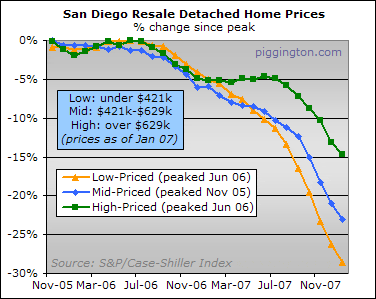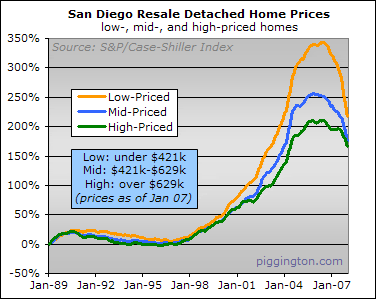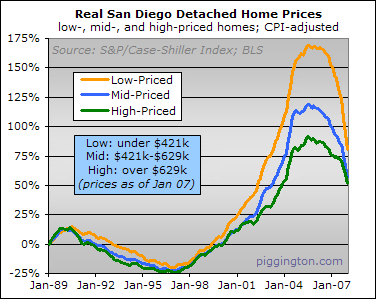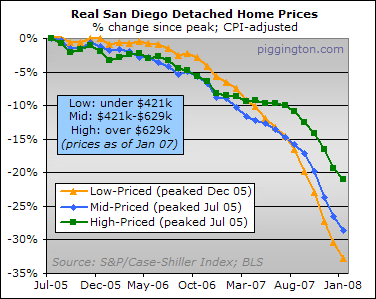The Case-Shiller home price index for San Diego didn’t get spanked as badly as it did last month but it was nonetheless down a substantial 2.5% for the month of January. This puts the total decline from the november 2005 peak through January 2008 at 21.1%.
Here’s how the three price tiers have fared since their respective peaks:

Wow — the low-priced tier is now gunning for a 30% decline from the peak (and has probably already passed it by now, considering that these are January numbers and that they average the sales results from Nov-Jan). Yet low-priced homes are still above their historical relationship to the higher tiers:

And, I might add, all three tiers are still above their prior relatoinships to everything else:

Here’s a close-up of the CPI-adjusted numbers since the peak.

Adjusted for CPI inflation, the low tier was already down a third as of January, wiping out 50% of gains. Even the allegedly immune high end has lost over 20% of its real value — a huge chunk of that correction having taken place in the past six months. Yet San Diego homes remain substantially overvalued (much more on that subject here) and the decline has not shown any signs of letting up yet. As a matter of fact, if the February size-adjusted median is providing a remotely accurate indication of actual price changes, next month could look a lot worse.

Rich, Nice update!
So, if
Rich, Nice update!
So, if one had bought a $650K home in 2005, then today, we might expect it to be worth 15% less, or basically $550K?
(High end of CS range lost 15% so far)Adjusting for inflation makes it look even worse in terms of what the dollar will buy.
Starting to really get into significant price declines in the upper end.
I’ve wondered about the
I’ve wondered about the effects of inflation on price drops.
With everything else going up, price declines are mitigated by rising inflation, is that correct? If so, then would today’s actual prices likely be even lower if inflation wasn’t so high?
With inflation showing no signs of slowing down even if we had flat prices, which the NAR would call a turn around, would be really declining…?
Rich, since you have pointed
Rich, since you have pointed out (and I heartily concur) that the government-published CPI numbers understate inflation, I’m curious what these charts might look like using a more accurate measure of inflation. Say, the dollar index. Or a specific currency like the Euro. Or a commodity index. Or what I would call “core” inflation, the compliment of what the Fed calls core inflation, only food and energy, the only core items that people can’t exclude from their budgets. This might paint an even uglier picture still.
Assuming CPI runs up at 3%
Assuming CPI runs up at 3% per year, and the bottom is reached in 2012 at 1997 real price levels, the Case-Shiller index would reach 111. This corresponds to 55 in 1997. 111 takes us back to 2000 price levels.
The mid, high and aggregate still have about 43% nominal drop yet to go. Low end has 48% nominal yet to go.
Good math fearful….but, I
Good math fearful….but, I think the bottom will be 2001-2002 prices. The dollar has fallen so much (50% since clinton left office) that Bush won’t allow the market to free fall, he’ll devalue the dollar enough to stop it. That said, I would love year 2000 prices, but there will be blood in the streets if that happens.
Factoring inflation is
Factoring inflation is difficult: The longer it takes to reach the bottom, the higher the bottom will be in nominal terms.
If the exit to this whole mess is via a devalued dollar (and thus foreign investment in U.S. real estate?) then the hedging strategy is to invest in non dollar currencies. There are plenty of World Bond funds, both mutual and ETF.
End of 2001 prices are not all that much higher than mid 2000, by the way. About 17%.